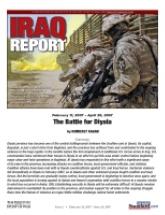 |
 |
The Battle for Diyala

Executive Summary
Diyala, one of the most chaotic provinces in Iraq, has become a central battleground between the Coalition and al-Qaeda. Prior to beginning major clear and hold operations in Baghdad, commanders attempted to control this area by reinforcing their troops. Al-Qaeda responded to this effort with significant surge of counterattacks. In spite of al-Qaeda’s surge, terrorists are losing ground, the local government is beginning to function, and the local population is turning against al-Qaeda. U.S. and coalition forces must, however, sustain their presence in Diyala to deter Iranian interference and prevent al-Qaeda from reestablishing control over the province.
Topic 1: How Diyala fits into Iraq
- Operations in Baghdad do not occur in vacuum. Diyala, one of Iraq’s most chaotic provinces, feeds the violence in Baghdad by providing bases for insurgents and al Qaeda (p. 2).
- In 2006 Diyala served as a terrorist stronghold outside of Baghdad province. U.S and Iraqi operations drove al Qaeda from its safe havens in the region (p. 2-3)
- Following the initial stages of Operation Enforcing the Law, al Qaeda and Sunni insurgents moved north and the Jaysh al Mahdi moved south (p. 3).
- General Odierno reinforced Diyala to handle the influx of enemy forces from Baghdad and to prevent al Qaeda and Sunni insurgents from terrorizing the local population (p. 3)
- Jaysh al Mahdi forces also operated in Diyala and “apparently relied upon weapons supplied from Iran” through the province’s lines of communication (p. 4)
Topic 2: Conditions in Diyala, early 2007
- The structure of Diyala’s population and its border with Iran is an ideal operating environment for al Qaeda and is also a target of the foreign fighter network that originates on the Syrian border (p. 4).
- Diyala serves as a conduit for Iranian weapons and advisors as well as attackers moving to and from Kurdistan (p. 4).
- After Saddam Hussein’s regime collapsed, former Baathists controlled Diyala and Abu Musab al-Zarqawi claimed a location in the province as the capital of the caliphate he intended to establish (p. 4).
- For most of 2006 and the first quarter of 2007, Diyala was not controlled by the Iraqi government of U.S. forces (p. 4)
- As sectarian violence erupted in Fall 2006, ethnic groups contested the area, Shiite militias and ISF forces killed hundreds of Sunnis, and Kurds migrated south toward the Iranian border (p. 4-5)
Topic 3: Operations in Diyala January-February
- When the Baghdad Security Plan started, U.S. and Iraqi forces also began conducting shaping operations in Diyala aimed at clearing the lines of communication, denying enemy sanctuaries, and securing the population (p. 6).
- Targeted raids in Muqdadiyah produced an al Qaeda cell leader and twelve weapons caches. These discoveries suggested that the road in Muqdadiyah was a major enemy supply-line (p.6).
- U.S. and Iraqi operations in Diyala demonstrated the variety of enemy forces present in the province: insurgents, al Qaeda, and foreign fighters (p. 7).
- As a whole, U.S. actions in Diyala began the intelligence preparation of the battlefield necessary for clearing operations (p. 7).
- To retain control of Muqdadiyah and its environs, U.S. forces began a neighborhood watch program that hires local residents to protect their own village (p. 8).
Topic 4: Reinforcement, March-April 2007
- In response to MG Mixon’s request, LTG Odierno reinforced U.S. troops in Diyala on March 13, 2007 thus increasing troop density and mobility in the province (p. 8).
- This reinforcement prompted attacks against ISF, coalition forces, and Iraqi civilians (p. 9).
- The multi-week clearing operation that lasted from March 24 through April 8 produced 60 al Qaeda terrorists, an al Qaeda training camp, and 15 substantial weapons caches (p. 9)
- After U.S. forces established seven combat outposts around Buhriz, tribal leaders began meeting and residents began volunteering information about the enemy (p. 10).
- Al Qaeda began to target the local Sunni population, but the provincial government in Diyala still resumed (p. 10).
Topic 5: Iranian Involvement
- During the first quarter of 2007, the enemy smuggled Iranian weapons into and through Diyala province (p. 10).
- Iraqi Police and coalition forces also discovered a cache of explosively formed projectiles (EFPs) imported from Iran. It is unclear whether the cache belonged to JAM, al Qaeda, or another insurgent group (p. 11).
- Iranians also provided services such as electricity to the citizens of Diyala (p. 12).
- An insurgent supply line ran from Iran through Muqdadiyah and into northern Baqubah (p. 12).
Possible Implications
- Disrupting lines of communication within Iraq’s provinces as well as from Iran and Syria will reduce al Qaeda’s ability to conduct attacks and perpetuate violence.
- Sunni insurgents, Shiite militia, and al Qaeda often occupy the same space and operate within a sophisticated network.
- Security in Baghdad will promote security in Diyala by enabling the central government to assist the provincial leadership with providing food and fuel (p. 14).
- Due to enemy force migration (caused in part by U.S. and ISF presence), weapons trafficking, a synthesis exists between violence in Baghdad and violence in the Iraqi provinces.
- Iran is assisting enemy forces and attempting to influence the Iraqi population.
Conclusion
Coalition clearing operations reversed the trend of increasing al Qaeda control. Success in Turki Village and the destruction of al Qaeda’s emirate south of Balad Ruz turned the local population against the terrorist organization. As a result, sectarian violence has decreased. The local government has also begun to regain effective control over the province. Despite these positive strides, much remains to be done in Diyala and violence there will probably outlast the beginning of major operations in Baghdad.
Maps
- Provinces of Iraq: Page 3
- Major Roads of Iraq’s Diayla Province & North of Baghdad: Page 5